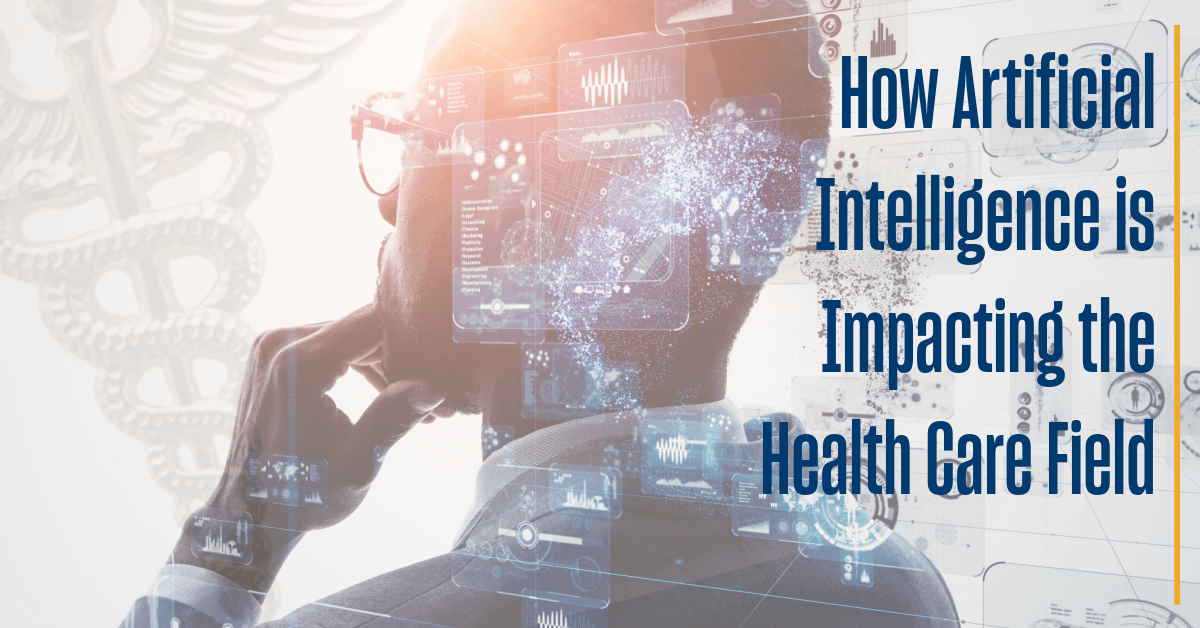
Technological innovations today — regardless of industry — are largely intended to save time, increase efficiency and ultimately improve outcomes for businesses and consumers. The growing use of artificial intelligence (AI) in health care is an important example of how the merger of innovation and medicine is making an impact for providers and patients alike.
At a high level, AI is driving sophisticated computations, analyses and research breakthroughs that would otherwise be nearly impossible. In the day-to-day, AI helps health care providers save time on repetitive administrative tasks, giving them more time to interact with patients, make important discoveries and ultimately deliver higher quality care than ever before.
But how is that possible? Here are just some of the many ways AI is impacting the health care field for the better.
What is AI and How is it Used in Health Care?
Artificial intelligence (AI) in health care is the use of algorithms and software in the analysis, interpretation and comprehension of complicated medical and health care data to ultimately improve treatment options and outcomes. Modern AI has come a long way, and is able to make determinations and find outcomes without direct human input.
A subdiscipline of AI, machine learning is also playing a critical role in health care applications. With machine learning, health professionals are able to develop new medical procedures, manage massive amounts of patient data and records and improve the treatment of chronic diseases. Computer scientist Sebastian Thrun put it best when he told the New Yorker, “just as machines made human muscles a thousand times stronger, machines will make the human brain a thousand times more powerful.”
A second, but equally important subset of AI known as natural language processing, or NLP, makes it easier than ever to automate many of the complex, time-consuming, repetitive tasks that eat up a lot of resources in health care administration. With NLP, health care organizations can dramatically increase efficiency and accuracy in critical areas of care.
For example, an article from the Healthcare Information and Management Systems Society (HIMSS), reports that natural language processing has been proven to improve outcomes and help providers deliver more personalized care. NLP can be used to translate clinical notes in electronic health records (EHRs), which means a clinician only needs to enter data once. When paired with AI-enabled software, NLP can also provide access to data from multiple sources — including medical images, EHR data and even consumer devices such as activity trackers, smartphones and connected medical devices. This expands the diagnostic and treatment options clinicians can propose, thereby improving the overall quality of care.
When referenced together, AI, machine learning, and even natural language processing encompass the abilities of technology and software to think, learn and analyze input like a person would, but at a much faster speed and with more accuracy.
As with many technologies, there is an adoption curve to AI and machine learning technologies in health care. But the outbreak of the COVID-19 pandemic has increased the speed with which these technologies have been adopted, and the applications can be seen in many areas of the health care field.
AI in Health Care Operations
Patient Data Management
Health care today is largely reliant on patient data, both to manage care and inform future treatments. And while data has helped spark new breakthroughs in medical discoveries, none of that would be possible without AI.
As Lily Peng, MD, PhD, product manager in the Google Brain AI Research Group, explained in a recent HIMSS article, “while human intelligence is best suited for integrating small numbers of very large effect factors, AI is particularly adept at combing through and identifying patterns in vast numbers and obscure factors.”
Chris DeRienzo, MD, MPP, FAAP, senior vice president, chief quality and medical staff officer, WakeMed Health and Hospitals, sees an additional benefit in how providers can leverage patient data to improve treatment of others. “The key benefits of artificial intelligence are grounded in this ability to continuously comb the electronic medical records (EMR), training on past patients’ trajectories in the same way clinicians are trained and hone the lenses of their own prescription glasses, patient by patient by the millions.”
Reimbursement and Billing
Complete, timely and accurate documentation is essential for accurate reimbursement. Documentation gaps can lead to inaccurate coding that may diminish revenue and slow the reimbursement process or stop it altogether. Chasing down deficiencies in documentation can impact cash flow. Claim denials resulting from inaccurate or incomplete documentation are costly to rework.
Documentation deficiencies and incomplete coding pose an even greater threat to revenue today than they did a few years ago. New risk-based models have introduced intricate rules that impact documentation, coding and reimbursement. As payment models shift, reimbursement is also tied to quality events that must be accurately reported based on what is reflected in clinical documentation. In addition to revenue, quality reporting to the Centers for Medicare and Medicaid Services (CMS) is public information, and the related ratings and penalties can shape community perception of the health care provider.
Intelligent automation that identifies documentation gaps and enables documentation improvement at the point of care supports accurate quality reporting, as well as accurate coding and efficient downstream revenue cycle processes that ultimately lead to appropriate revenue capture.
Precision Medicine
According to the U.S. National Institutes of Health, precision medicine is “an emerging approach for disease treatment and prevention that takes into account individual variability in genes, environment, and lifestyle for each person.” Using AI, precision medicine can be made even more effective in accurately applying treatment and prevention options based on an individual’s unique characteristics.
As mentioned previously, one of the greatest advantages to AI and machine learning is the speed with which both of those technologies can process data to determine actionable outcomes. In terms of precision medicine, this means quickly “mining and analyzing large quantities of genetic, clinical, social, lifestyle and preference data across broad, heterogenous populations,” wrote Dixie B. Baker, PhD, FHIMSS, senior partner, Martin, Blanck and Associates.
Cost Savings
There is an estimated $91 billion wasted in health care spending every year, and much of that unnecessary cost comes from inefficient administrative practices. Thankfully, this is one area of health care operations that can implement AI and machine learning tools fairly seamlessly with little to no interruption.
Administrative, repetitive tasks that can be automated with AI are things like billing, patient check-in, filing, data input and more. When a health system moves those tasks to AI, that allows them to shift the focus of their most valuable resources — providers and health care professionals — to delivering care.
AI in Clinical Decision Support, Diagnosis & Treatment
The impact of AI goes beyond using data to influence health care research and diagnostics, it is also changing the way health care providers make clinical decisions.
Because AI computers have the ability to “learn” from endless data sets and uncover patterns in this data, it is now being used to positively influence many areas of clinical care. What’s more, AI and machine learning are helping providers deliver more personalized medical treatments and care.
“Consider all the vast amounts of data that AI has the potential to harness — from genomic, biomarker and phenotype data to health records and delivery systems. The technology is already being used to support decisions made in data-intensive specialties like radiology, pathology and ophthalmology,” according to HIMSS.
Some examples of ways AI is already improving health care decision-making, diagnosis and treatment include:
- AI is helping determine the appropriate number of days a patient should stay in the hospital. This ultimately improves decision making, care planning and patient management, which should prevent complications, improve patient outcomes and reduce costs to health care facilities and patients.
- In the fight against cancer, IBM’s Watson is being utilized by researchers to better pinpoint effective treatment options. At the University of North Carolina Lineberger Comprehensive Cancer Center, IBM Watson for Genomics was used to identify specific treatments for over 1,000 patients. AI-powered solutions performed big data analysis to determine treatment options for these people with specific tumors who were showing genetic abnormalities, more efficiently identifying more optimal treatments.
- The Google Cloud Healthcare API leveraged its data to build an AI system to help reduce readmissions and shorten the amount of time patients are kept in hospitals. The AI used in the Google Cloud was able to utilize data from patients’ EHRs through machine learning, ultimately giving health care providers better data and insights to make better clinical decisions.
- The IBM software program Avicenna can scan, read and identify abnormalities in medical images such as CT scans and X-rays. It can even compare the results to other data in a patient’s medical records to recommend the next step in treatment. Avicenna works by “looking at medical images using a suite of different image-processing algorithms with different specialties. Some have been trained to judge how far down a patient’s chest a CT scan slice is from, for example. Others can identify the organs or label abnormalities such as blood clots.”
Regardless of the many technological advancements that have been and will continue to be made in the medical field, health care will always be about human-to-human care and contact. But with AI, health care professionals across disciplines are able to gain new insights and improve the ability to provide care. A secondary but equally important benefit of AI in the health care setting is that it frees up providers to do more patient-centric work simply by offloading simpler or more menial tasks to automated solutions.
How AI Can Improve Patient Engagement
The Internet of Things (IoT), powered by AI and machine learning capabilities, makes it easier than ever for patients to be proactive participants in their own health care. From accessible EHR information through online platforms to sharing personal health data from wearable devices, technology-driven opportunities for patient engagement continue to expand.
One example of proactive patient engagement made possible by AI is currently being used at Harvard Medical School. They have recently deployed an AI-powered chatbot program to more quickly diagnose and treat patient symptoms. The app, known as Buoy Health, allows patients to chat with a bot and describe their symptoms and concerns. The app can then process that information based on actual health data and insight, and direct the person to the type of treatment they need to seek out.
With this level of AI-powered interaction comes new and improved communication between health care providers and their patients, which is ultimately resulting in a new level of more personalized care. The volume of data AI processes, paired with people sharing more of their own health data, gives doctors greater insight into patterns of symptoms and treatment strategies that enhance patient success. “Unlocking data [on health conditions] that historically we’ve made simple decisions about, AI allows us to get much deeper and look for associations the human brain isn’t able to do … but a computer can,” said Dr. David B. Agus, MD.
Future Implications of AI in Health Care
There is no doubt that the impact of AI on our health care system will continue to grow. As it stands now, AI is helping drive innovations in pharmaceutical development, diagnostic practices and overall health care operations. But looking at the technology that is in development, it is clear that AI will soon be an integral part of day-to-day health care functions in a way that will benefit patients and medical facilities alike.
First, in the realm of health care administration. According to Business Insider Intelligence, 30% of health care costs are associated with administrative tasks. AI can automate some of these tasks, such as pre-authorizing insurance, following up on unpaid bills and maintaining records. It is even reasonable to expect that checking in at medical facilities — from the emergency room to regular clinics — will be handled by automated kiosks powered by AI. This isn’t to say that AI is replacing people’s jobs, but rather lightening the workloads so more time can be allocated to more value-added tasks.
Some health industry experts believe AI will begin to mine the same data that is widely used in modern marketing. “For example, if I buy hiking boots online, suggested items pop up that I can use as well, like bug spray or sunscreen. The data analytics behind those recommendations includes a wealth of information about me — my demographics, such as age, gender, education and income level, as well as where I live and other factors that influence my buying decisions,” said Mark Weber, senior vice president, Infor Health Solutions. “My prediction is that we will be able to apply the same principles to healthcare data — to improve patient outcomes, costs and efficiencies.”
Evidence-based medicine will also benefit from AI, but more specifically, NLP. Natural language processing is already used to identify missing medical records, but in the future, it could very likely be used to spot deficiencies in treatments or diagnosis. Using what is known as clinically intelligent NLP, many experts believe AI will be able to find evidence of misplaced care or less-effective treatment, and alert physicians to make a correction. This ultimately will result in more successful outcomes for patients and fewer readmissions.
Another likely innovation driven by AI will be what is known as the triage function. The triage function is an algorithm tied to wearable devices that will use insights driven by health informatics to deliver real-time alerts to patients. In the event that a device detects an abnormal medical event, it will not only alert the wearer that there is a problem, it can even make the initial call to a physician or hospital.
Improving quality of care for
patients and delivering the best possible outcomes will always be the
ultimate goal of health care providers. In
pursuit of that mission, more and more health care professionals are
seeking out programs that offer specialized education opportunities in
health informatics, data science or both. The University of San Diego has a unique track within its Health Care Informatics master’s degree program
that marries the two specialties — health informatics and data science —
to prepare learners to develop groundbreaking, data-driven solutions in
the health care industry.

